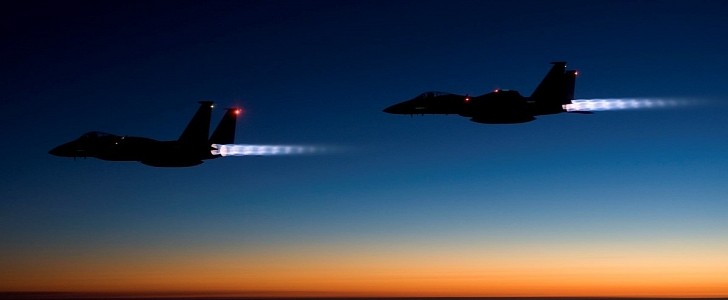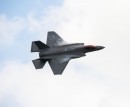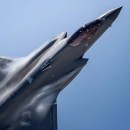Fighter jets are undoubtedly the most famous aircraft in the skies, and for a good reason. They represent the culmination of the eternal dream of flight of countless generations. They are majestic flying machines, and their air abilities are unmatched.
Nellis Air Force Base in Nevada teases us with a couple of masterpieces, one courtesy of the Air Combat Command Instagram account and the other via the Nellis AFB’s social media post. Two equally spectacular moments, with two fantastic protagonists.
The first one is an F-15E of the 422d Test and Evaluation Squadron and the video – tantalizingly slow-motioned – gives us a glimpse of what a take-off in style is all about. Filmed during a Black Flag exercise held recently at the Nevada airfield, the jet – majestically liveried in dark matte colors – ripples through the hot air of the desert with the stream of hot gasses ejecting out its engine nozzle.
Just as spectacular, if not more so, is the F-35 that takes to the air at dawn, with the stunning Las Vegas backdrop shining behind the turbulent superheated flow of jet engine flames. To me, that gives the “firepower” a whole new twist and puts the “power” in that “firepower.”
Separated by nearly 40 decades, the two combat aircraft serve the same ultimate purpose – reign supreme in the sky and keep all foes at bay. Although the older F-15 is more prominent in all aspects (wingspan, length, and height), it is also lighter than its younger sibling. And the 40 years in avionics development become apparent, with the fifth-generation fighter backed by a single engine almost as powerful as the F-15’s twin turbofans.
The Pratt & Whitney F100-PW-220 afterburning pair on the Eagle can generate 29,180 lbf (64.9 kN) of thrust – 47,440 lbf (105.7 kN) with an afterburner. The Lightning’s Pratt & Whitney F135-PW-100 is suitable for 28,000 lbf (125 kN) of thrust dry and 43,000 lbf (191 kN) with a full afterburner.
However, the stealthy youngster is seriously outpaced in the top speed, ferry and combat range, and service ceiling. The F-15 can hit Mach 2.5 (1,650 mph, 2,655 kph) at high altitude and Mach 1.2 (921 mph; 1,482 kph) at sea level, which is way faster than the maximum speed (at altitude) of Mach 1.6 on which the F-35 can rely. On the other hand, since no one can see it coming, the F-35 is just as formidable a striker at lower speeds.
As for firepower, suffice to say that any of these two can unleash doomsday with one push of a button, given their devastating arsenal-carrying capacities. That’s why these great warbirds are best seen during regular exercise flights and not in their natural habitat. I can’t choose a favorite from the two videos, but feel free to take sides. Either way, it’s a win-win scenario.
The first one is an F-15E of the 422d Test and Evaluation Squadron and the video – tantalizingly slow-motioned – gives us a glimpse of what a take-off in style is all about. Filmed during a Black Flag exercise held recently at the Nevada airfield, the jet – majestically liveried in dark matte colors – ripples through the hot air of the desert with the stream of hot gasses ejecting out its engine nozzle.
Just as spectacular, if not more so, is the F-35 that takes to the air at dawn, with the stunning Las Vegas backdrop shining behind the turbulent superheated flow of jet engine flames. To me, that gives the “firepower” a whole new twist and puts the “power” in that “firepower.”
Separated by nearly 40 decades, the two combat aircraft serve the same ultimate purpose – reign supreme in the sky and keep all foes at bay. Although the older F-15 is more prominent in all aspects (wingspan, length, and height), it is also lighter than its younger sibling. And the 40 years in avionics development become apparent, with the fifth-generation fighter backed by a single engine almost as powerful as the F-15’s twin turbofans.
The Pratt & Whitney F100-PW-220 afterburning pair on the Eagle can generate 29,180 lbf (64.9 kN) of thrust – 47,440 lbf (105.7 kN) with an afterburner. The Lightning’s Pratt & Whitney F135-PW-100 is suitable for 28,000 lbf (125 kN) of thrust dry and 43,000 lbf (191 kN) with a full afterburner.
However, the stealthy youngster is seriously outpaced in the top speed, ferry and combat range, and service ceiling. The F-15 can hit Mach 2.5 (1,650 mph, 2,655 kph) at high altitude and Mach 1.2 (921 mph; 1,482 kph) at sea level, which is way faster than the maximum speed (at altitude) of Mach 1.6 on which the F-35 can rely. On the other hand, since no one can see it coming, the F-35 is just as formidable a striker at lower speeds.
As for firepower, suffice to say that any of these two can unleash doomsday with one push of a button, given their devastating arsenal-carrying capacities. That’s why these great warbirds are best seen during regular exercise flights and not in their natural habitat. I can’t choose a favorite from the two videos, but feel free to take sides. Either way, it’s a win-win scenario.













